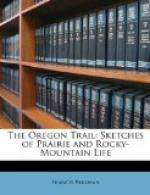We encamped that evening at a short distance from the river bank. About midnight, as we all lay asleep on the ground, the man nearest to me gently reaching out his hand, touched my shoulder, and cautioned me at the same time not to move. It was bright starlight. Opening my eyes and slightly turning I saw a large white wolf moving stealthily around the embers of our fire, with his nose close to the ground. Disengaging my hand from the blanket, I drew the cover from my rifle, which lay close at my side; the motion alarmed the wolf, and with long leaps he bounded out of the camp. Jumping up, I fired after him when he was about thirty yards distant; the melancholy hum of the bullet sounded far away through the night. At the sharp report, so suddenly breaking upon the stillness, all the men sprang up.
“You’ve killed him,” said one of them.
“No, I haven’t,” said I; “there he goes, running along the river.
“Then there’s two of them. Don’t you see that one lying out yonder?”
We went to it, and instead of a dead white wolf found the bleached skull of a buffalo. I had missed my mark, and what was worse, had grossly violated a standing law of the prairie. When in a dangerous part of the country, it is considered highly imprudent to fire a gun after encamping, lest the report should reach the ears of the Indians.
The horses were saddled in the morning, and the last man had lighted his pipe at the dying ashes of the fire. The beauty of the day enlivened us all. Even Ellis felt its influence, and occasionally made a remark as we rode along, and Jim Gurney told endless stories of his cruisings in the United States service. The buffalo were abundant, and at length a large band of them went running up the hills on the left.
“Do you see them buffalo?” said Ellis, “now I’ll bet any man I’ll go and kill one with my yager.”




